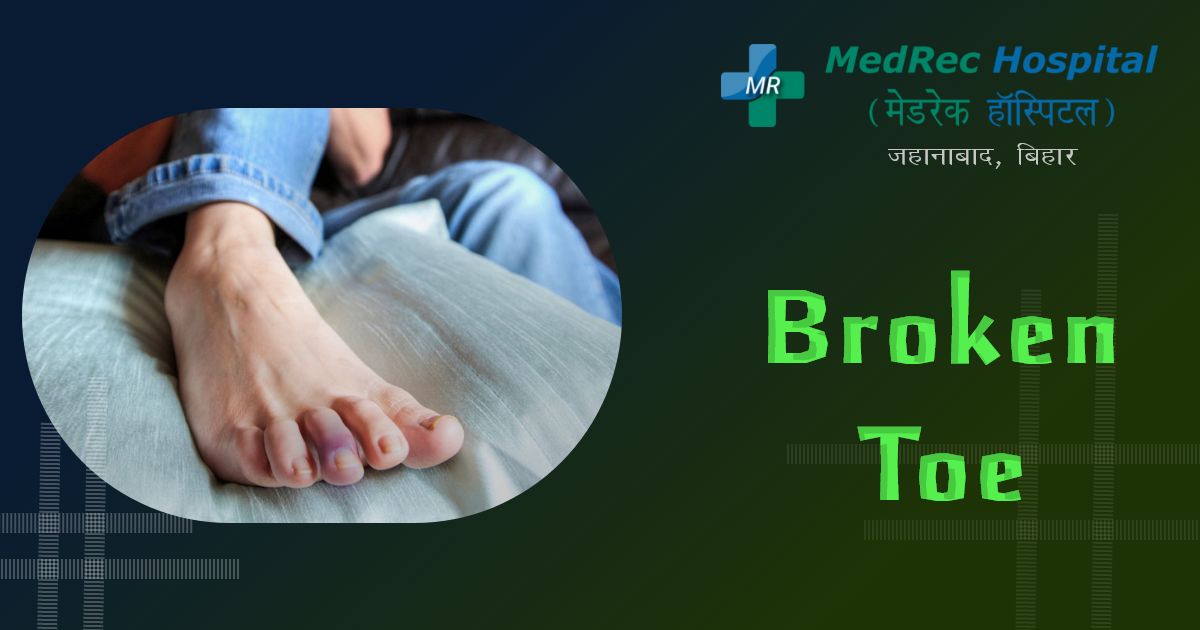
Broken Toe : A Comprehensive Guide to Treating a Broken Toe
817
Common accidents like dumping something on one's foot or stubbing one's toe can result in broken toes.
A fractured toe is typically fixed by taping it to the toe below. However, if the fracture is significant, particularly if it affects the big toe, full healing may necessitate the use of a cast or possibly surgery.
The majority of fractured toes mend quickly, usually in 4 to 6 weeks. A broken toe can, however, occasionally become infected. The break may also make that toe more susceptible to developing osteoarthritis in the future.
Causes
The most frequent causes of a broken toe include striking the toe against anything hard and dropping something heavy on the foot.
Two of the most frequent ways for a toe to break are by hitting something hard or by having something heavy fall on it. A significant risk is walking barefoot, particularly at night or in an unknown setting.
You have an increased chance of breaking a toe if you carry large goods without wearing appropriate foot protection, like thick boots.
How to check if you have a Broken Toe?
Consult a medical professional if the injury prevents you from walking or wearing shoes or if the pain, swelling, or change in skin colour lasts for more than a few days.
Symptoms
Broken toe symptoms and warning signs include:
- Pain
- Swelling
- Skin colour modification brought on by trauma or internal bleeding
The first indication that a toe may be shattered is sharp discomfort. At the time of the injury, you might also hear the bone snap. A fractured bone, also known as a broken bone, can enlarge where it has broken.
The skin near the injury may appear bruised or momentarily change colour if you have broken your toe. Additionally, it will be difficult for you to put any weight on your toe. Standing or even just walking can hurt. The toe may dislocate as a result of a bad break, which may cause it to rest at an unusual angle.
A dislocated toe should not appear to be sprained. It will probably bruise less, but it will still swell. A sprained toe may hurt for a few days, but it should eventually get better.
The location of the pain is another important distinction between a break and a sprain. Usually, a break causes pain where the bone has shattered. An area around the toe may experience more intense pain from a sprain.
Visiting your doctor is the only way to determine for sure whether the injury is a break or a sprain. They can look at your toe and identify the injury.
Treatments
Medications
Typically, non-prescription medications like ibuprofen (Advil, Motrin IB, and others), naproxen sodium (Aleve), or acetaminophen (Tylenol, among others) can help you manage the pain from a broken toe. Prescription medicines could be necessary for severe pain.
Reduction
A healthcare professional might need to reassemble the shattered bone parts if they do not fit tightly together. Reduction is the name for this. Typically, the skin is not cut throughout the procedure. The toe is numbed by ice or an injection of anaesthesia.
Keeping the toe still
A broken bone needs to remain immobile in order for its ends to naturally mend.
Examples comprise:
Buddy Taping. A simple fracture of any of the smaller toes can be treated by taping the afflicted toe to another. Perhaps just having something nearby will do. The healthy toe serves as a splint. To avoid skin irritation, use gauze or felt between the toes before taping.
Wearing shoes with a rigid bottom. A post-surgical shoe with a firm bottom and a soft top that fastens using fabric strips may be prescribed by a caregiver. This can restrict movement and give swelling more room.
Casting. A walking cast might be helpful if the broken toe's components will not fit together tightly.
Surgery
To maintain the bones in place during healing in some circumstances, a surgeon may need to use pins, plates, or screws.
Recovery
Even after a few weeks, your toe is probably still going to be sore and swollen. After your injury, you will probably need to refrain from jogging, participating in sports, or taking long walks for one to two months.
If one of the metatarsals is broken, recovery time may take longer. The long bones of the foot, known as the metatarsals, are joined to the phalanges, or smaller bones in the toes.
Based on the severity and location of your injury, your doctor can provide you with an accurate recovery time estimate. For instance, a little fracture should recover more quickly than a more serious break.
You should be able to walk and resume the majority of non-strenuous activities within a week or two of the injury with a walking cast.
Complications of Broken Toe
Possible complications include:
Infection. The likelihood of developing a bone infection rises if the skin is sliced close to the hurt toe.
Osteoarthritis. When one of the toe joints is broken, the wear-and-tear type of arthritis is more likely to develop.
For further information please access the following resources:
Emergency : +91 89686 77907
Front Desk : +91 98018 79584
Page last reviewed: Mar 10, 2023
Next review due: Mar 10, 2025







.jpg)
.jpg)
.jpg)
.jpg)
.jpg)
.jpg)